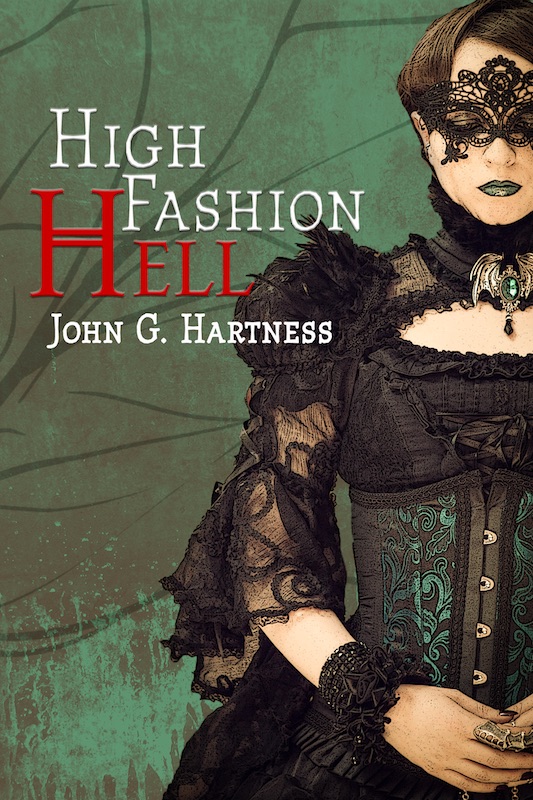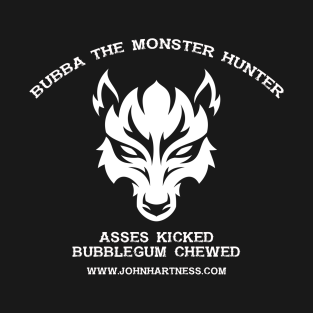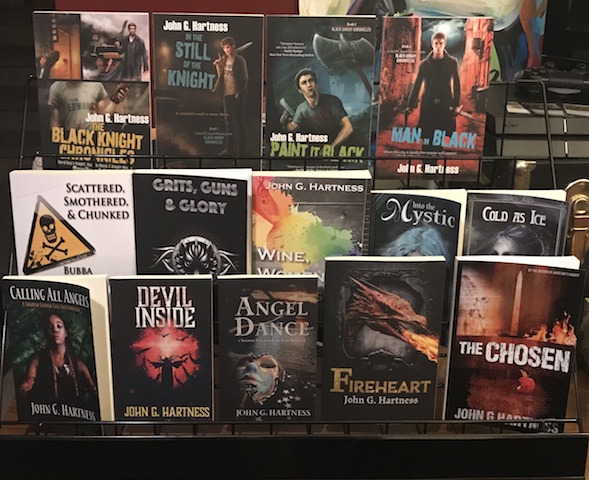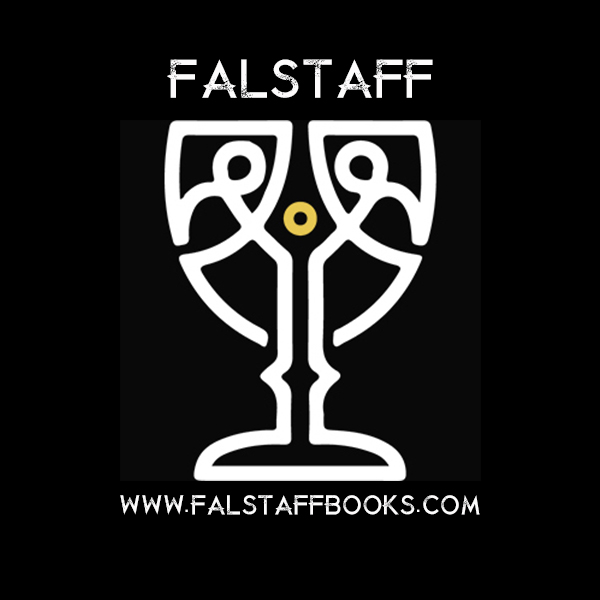by john | Feb 25, 2015 | Book Spotlight, Evolution of Evil, Promos/Giveaways
Stories Beyond Good and Evil
By Neal F. Litherland
Have you ever heard of the gods Czernobog and Belobog? These were old Slavic gods, a Black God and White God respectively, who were responsible for bad things and good things. In some myths they were brothers, in others the same being who changed with the seasons (a common motif). While there’s still research going into understanding the beliefs of the Slavic peoples these gods come from, the point is that these figures represent one of the earliest points in world religion where there was a definite good god and a definite evil god. There was an angel and a devil, a light and a darkness, and you could always count on them to be responsible for their chosen deeds.
Before that was chaos. One day your crops might get rain, because the gods have deemed it so. The next day savage predators might sweep down from the mountains, kill all your livestock, and cripple your son because the gods have deemed it so. The gods were to be feared and placated, and their favor curried, but there were no labels put on their actions. Whether they were helpful or harmful the gods did as they pleased. There was no good, and there was no evil; only power.
My story “Little Gods” takes that sort of old-world chaos and sets it down in Chicago’s seedy underbelly to play in the muck.
What’s Compelling About That?
The story’s premise is simple enough. Warlock-for-hire Richard Blackheart is given a job by a disgraced Santera to help her steal the mantle of the little god of murder. If she can usurp the Hook Man’s place in the pantheon of the city then she’ll gain immortality and power, finally able to leave mortal flesh behind and step into the demimonde where mortals can only tread on little cat’s feet. She can’t do it without one of the city’s occult heavies backing her play, but The Bad Luck Man has motives of his own when he agrees to help her.
Why should you want to read that? On the one hand it’s a dark modern fantasy that steps off the path and drags you through the dark forest alongside the wolves instead of to the path to grandma’s house. Also because without a hero or a villain you’re left to make your own decisions about what’s right and wrong, what’s deserved and what isn’t. In the absence of a white knight (or really any sort of knight) every reader has to decide for themselves what the story means. Or if in the end it’s another of the myths we tell where there is no hero or villain; only the gods throwing rocks into the little mortal pool and making the ripples that shape our world.
Check out more Neal on the web here!
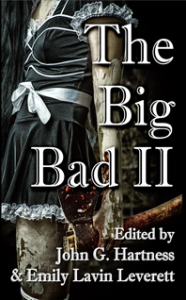
by john | Feb 23, 2015 | Book Spotlight, Evolution of Evil, Writing
Quieter Horror
by J. T. Glover
Late in 2013 I sprained my back, and several months passed while it healed. During the period when my spine looked less like a straight line and more like a question mark, I wrote “Mercy’s Armistice” for The Big Bad II. Most of it was dictated using speech recognition software, because sitting down for long periods was out of the question—standing was only somewhat less painful, but lying down actually worked all right. Things came together, I submitted the story, and John & Emily took it.
What does my tale of woe have to do with the evolution of evil? Just this: by the time I actually started writing, the pain was large enough that I was distracted. Decayed noblemen with fangs and capes seemed patently ridiculous, and the same went for most everything else from the canon of Big Bads. The zombie apocalypse is a very distant concern when you’re dropping mugs, showering is a fraught activity, and getting into a car involves an IKEA-like diagram of turns and shifts.
One afternoon in December I wound up re-watching The Godfather for the nth time, and something clicked. The world that Mario Puzo described and Francis Ford Coppola immortalized is made up of those who are family, those who are not, and those who wish they were. What, I started to wonder, about the people who weren’t part of any of that, or of the square world? What about the true outsiders—skip the heroin chic, dodge the beautiful gutters—what about the truly desperate?
And then, as often happens for me, I put two and two together. What happens when hit men get old? Luca Brasi wasn’t a young man when he went to sleep with the fishes, but we saw little of his mundane life. Everyone ages, contracts this or that illness, eventually dies—but most of that doesn’t happen on screen. “How” I asked myself, “would it work for a couple of aging supernatural predators who had to take care of a sick relative?” That was the point at which the engine actually turned over and the Muse took the wheel.
I like the tight, well-plotted headliners of horror that sweep me along, but I also like the quiet and mundane: Caitlín R. Kiernan’s “Standing Water,” T.E.D. Klein’s “Growing Things,” David Searcy’s Ordinary Horror, any number of stories by Shirley Jackson. The empty spaces between the evisceration of hapless victims and the howl of the Beast can be horrifying, too. In those moments, I think it’s easier to look past the fur and the fangs and see the so-familiar face that hides underneath the mask.


by john | Feb 20, 2015 | Book Spotlight, Evolution of Evil, Writing
James R. Tuck is my brother from another mother, one of my favorite people, one of my favorite writers, and one of the best friends I’ve got in this business. I love everything he writes, from Deacon Chalk to the Big Bad, and it’s always an honor to have him share his words with me in these anthologies. Here’s his story about his story.
It’s Neil Gaiman’s fault.
Kind of.
Well, he’s good enough to blame anyways.
My story in the last one had a supervillian, and he was evil, but for Big Bad 2 I wanted to go really evil. Old school evil. Hardcore evil.
I put on my thinking cap and came up with the concept of the Devil in a concentration camp.
Can’t really get more evil than that now can you?
I needed a reason for him to be there and so I ripped off Gaimen. In my story, we have a Devil who, as part of his curse, is forced to live a human life every year. (If perchance you do not know how this is ripping off Neil Gaimen then stop and immediately order DEATH: THE TIME OF YOUR LIFE by him. Hell, just go ahead and pick up the Sandman Omnibus vol 1 & 2. You’ll thank me for it.) This fits with the narrative of the Bible as we have a few occurances of Old Slewfoot showing up and actually being a real presence.
The Devil HATES these days and he doesn’t ever want to do them. He’s been able to push off these mandatory human life days longer and longer as his power grows. This is the reason he believes he will one day be able to win his struggle against God.
However, the day has come upon him in the middle of World War 2, and he decides to take over the life of a concentration camp guard.
My plan when picking this was to go full-bore evil. I had the Devil’s number, got him in one fell swoop as a right bastard, just the kind of prick you’d think the Prince Of Darkness would be.
Oh, this story was going to be some truly twisted, therapy-inducing horror.
Then Hadassah showed up.
Simple Hadassah. Straightforward Hadassah. Courageous Hadassah.
She ruined my plans and made this story about something else, something more. There is evil here, it’s on the page and in the subtext, but with Hadassah the story became about humanity. The ability we have to hold to our own faith and dignity even in the very mouth of the devourer. I’ve written many tales in my time. Some of them have been damn good.
This story is one of them I am most proud of.
It’s outside my wheelhouse, far outside my voice, and it’s about something.
No, it’s about somethings. There’s a texture to it that I’m pleased with. Normally I write very surface, guns and monsters and things that go boom, but not in this time.
This is a quiet story.
Enjoy.


by john | Feb 19, 2015 | Book Spotlight, Writing
Don’t Breathe Out
by
Sarah Joy Adams
Some things were strictly forbidden in my house while I growing up and Horror was definitely on the list. My mom had seen a horror movie once, peeking out from behind my grandfather’s armchair when she was supposed to be asleep, and it gave her nightmares for years. Between my mother’s (entirely understandable) desire not to let her kids have their own years of nightmares and the fact that we didn’t have cable there weren’t a lot of opportunities for me to find out what horror was. I grew up with the vague impression that horror meant Stephen King and teenagers getting hacked to pieces. Since I liked my teenage babysitters and had enough childhood fears of my own to be getting on with, the prohibition on Horror was not one I was eager to break.
Besides, my local library had plenty of other books for me to read that were perfectly acceptable. Mythology was a whole other thing, right? And the Brother’s Grimm was fairytales, so that was okay. And ghost stories were….okay, mom probably didn’t want me reading those either, but I snuck a few home every once in a while, telling myself that they didn’t count because they were real. So I grew up reading about Blue Beard’s Chamber and Saturn devouring his children and any number of creepy old houses inhabited by vengeful spirits. Not to mention Little Red Riding Hood – for years, I was sure there was a pony sized wolf waiting behind the bathroom shower curtain to eat me all up.
The result was that I grew up without a sense of horror as a genre, but a really strong sense of what was horrifying. For me it’s not about big scary monsters, but about visceral, lingering fear. This is why Jabba the Hutt’s rancor monster trying to eat Luke was, to me, just a cool fight scene, but his little dog-rat-thing chewing on C3PO’s eye was the stuff of nightmares. Give me a good light saber and that monster’s dead. But the little rat thing will sneak up on you and eat your face when you’re most vulnerable. This is how Lovecraft managed to make geometry and colors terrifying. (If that doesn’t ring a bell go read “Brown Jenkin” and “The Colour out of Space.” Just don’t read them late at night.)
It can be sudden and bladder clenching or it can be slowly dawning realization, but either way, effective horror induces what Emily Dickinson called the “zero at the bone.” Good horror is the difference between gore and pain. Blood is just blood. It can be cleaned up. It can even be funny. Pain is inside you, inescapable. Effective horror creates that gut clenching fear of inescapable pain. It makes you feel small and helpless, that your only hope is to freeze so the evil thing doesn’t see you.
Read more from Sarah in The Big Bad 2!

by john | Feb 16, 2015 | Book Spotlight, Evolution of Evil, Writing
Am I Evil?
By Jay Requard
Believe it or not, I’m pissed off.
I’m pissed off because I failed Conjer, Emma, and whoever that vampire-fop that ended up beheaded at the end of the third act. I failed them all, and every bit of it has to do with the fact that I didn’t know if I could be what I needed to be. I didn’t know if I could be evil. I consider myself a Heroic Fantasy author, so you probably imagine the kind of cognitive dissonance that entailed.
The first story, The Chase, appeared in The Big Bad: An Anthology of Evil, which featured many great stories featuring truly messed-up things being done by really messed-up people. But that didn’t mean we did evil. I am one of those (psychos) that take the time to read the reviews that followed on Amazon, and beyond a lot of really nice reviews and some well-earned praise for some really talented authors, there was one review that struck me in the face with shame.
“They’re really light on evil,” is essentially what was said, when paraphrased to protect who said. I’ll leave it to you to go and guess which review I’m talking about.
“Light on evil.”
That’s not good enough. It’s not good enough for me, specifically, because I know that I failed. I tried to make Conjer a darker, moodier version of The Man with No Name, one of my favorite characters from the Sergio Leoni-classics. Yet that character isn’t inherently a villain, and villains are supposed to be the bread and butter of The Big Bad II.
So here comes The Big Bad II. I submitted Ghosts and Sands to Emily Leverett and John Hartness, having to fight my way again into the second anthology. I wasn’t invited, I wasn’t called to submit another story—I had to work. And I had to figure out “am I evil?”
To me, evil is someone walking into town knowing he is going to kill scores and smiles about it. To me, evil is killing someone who was trying to do a job they didn’t want to be doing in the first place. To me, evil is making victims pay for rescue and salvation. To me, evil is having a good time doing it.
These are things that happen every single day in the real world, performed by those high and low, lawful and criminal. They may seem mundane to readers, in the grand scheme of things, but that’s because the readers are evil too—they accept this deepening shithole around them while they turn to the next page.
Conjer came back, ready to unleash hell. He’s not the hero you need; he’s the curse you have to endure. And curses always find a way to claim you.
I hope I didn’t fail this time. You can be the judge and answer my question: Am I Evil?

by john | Jan 29, 2015 | Book Spotlight, Writing
I promised y’all another edition of The Big Bad, and while it took all of 2014 and a little piece of 2015 to deliver, it’s coming now! The Big Bad II will release on February 24th from Dark Oak Press and Media, and here’s the awesome cover!

Volume 2 includes more stories of evil and monsters like:
Mercy’s Armistice – J. T. Glover
A Family Affair – Selah Janel
Old Nonna – Gail Z. Martin
Letters to Logroth – Jason Corner
Skippin’ Stones – S. H. Roddey
The Sea Witch – Kasidy Manisco
A Day in the Life – James R. Tuck
Overkill – Sara Taylor Woods
Voodooesque – Eden Royce
A Fitter Subject for Study – Sarah Joy Adams
Ghosts and Sands – Jay Requard
Teacher of the Year – Riley Miller
Feels Like Justice to Me – Edmund R. Schubert
Portrait of the Artist as a Psychopathic Man – Stuart Jaffe
The House on Cherry Hill – Emily Lavin Leverett
Sticks and Stones – Bobby Nash
Sweet Tooth – Nicole Givens Kurtz
Just Pretending – Linden Flynn
Phone Home – E. D. Guy
I Think of Snow – J. Matthew Saunders
Little Gods – Neal F. Litherland
Drawing Flame – Misty Massey
The Witch Hunter – M. B. Weston
The Cully – D. B. Jackson
You might notice that there is a name missing from that list – mine. I don’t have a story on this year’s anthology, sorry to say. With everything that went on in my life in late 2014, I couldn’t pull my crap together enough to write a good one, and anything I had working wasn’t of a quality to stand beside the stories we had, so I decided not to include a story. I also stepped away from a lot of the editing, leaving the lion’s share of the work to Emily Leverett, who stepped up and made the whole thing happen. We still have a book that we’re both proud of, with some incredible stories by new and established writers, and a couple of tie-ins to existing story or novel series that I can’t wait for y’all to read. This is an incredible collection, and I’m thrilled for y’all to get it in your hot little hands.

